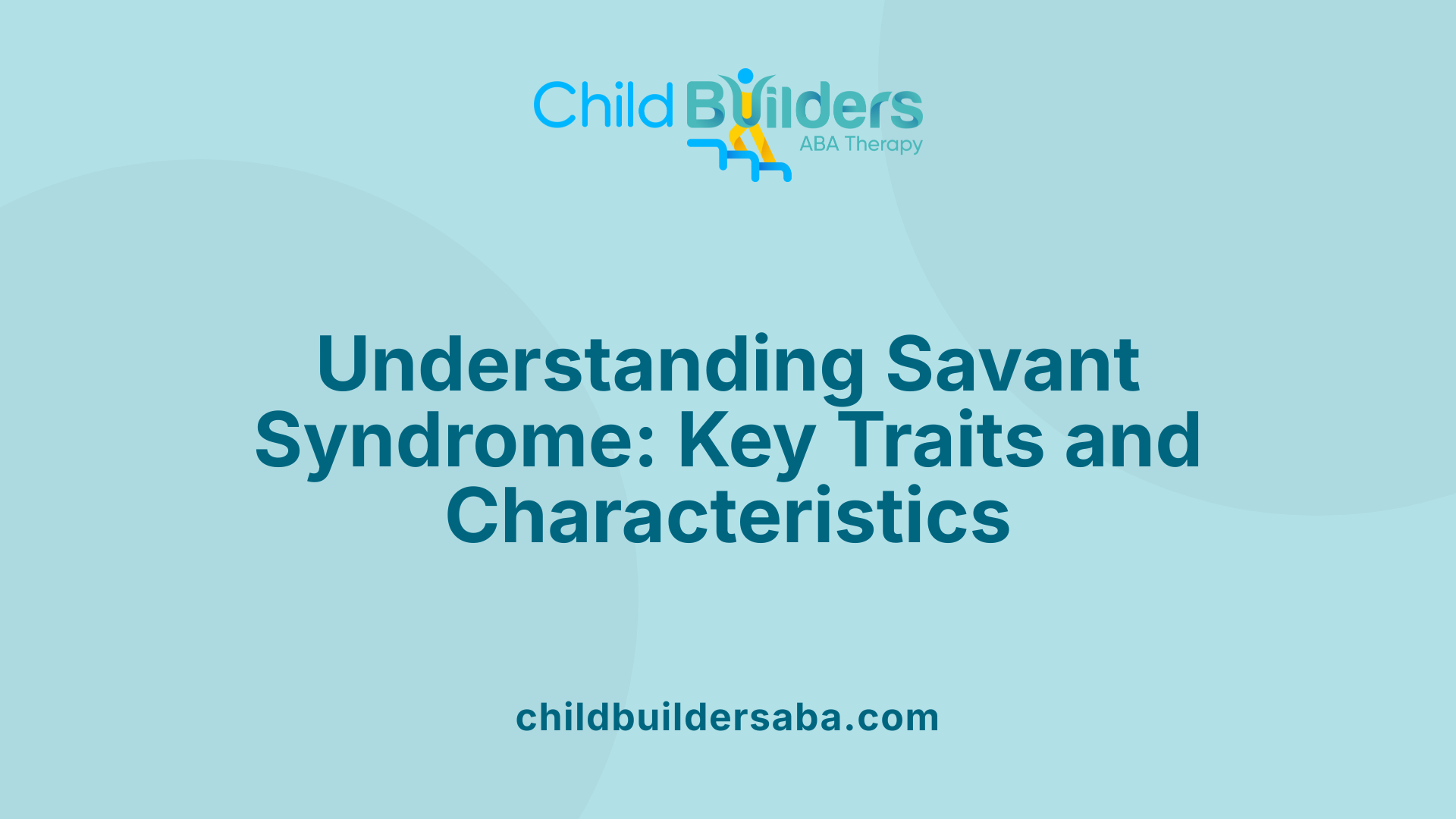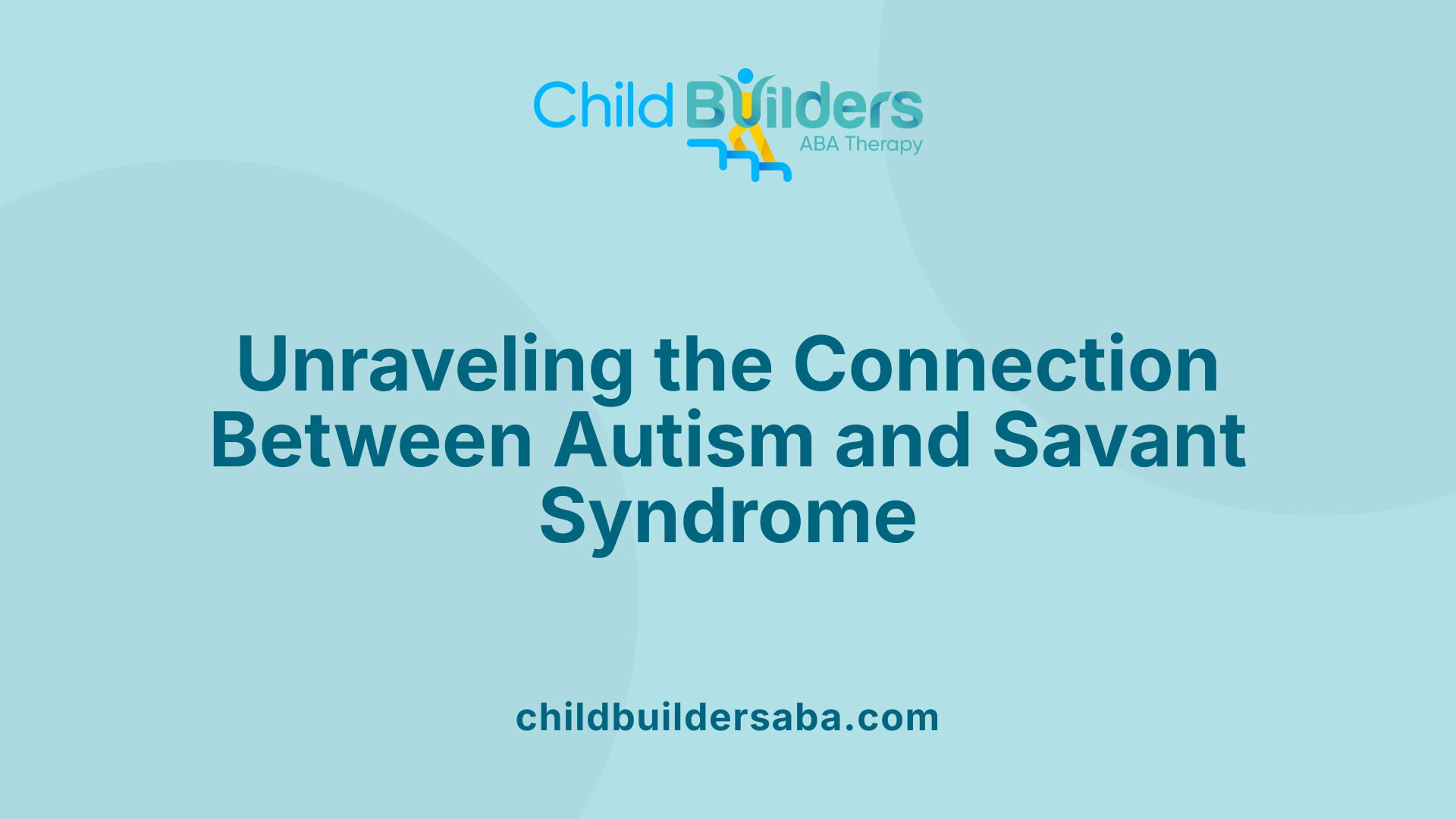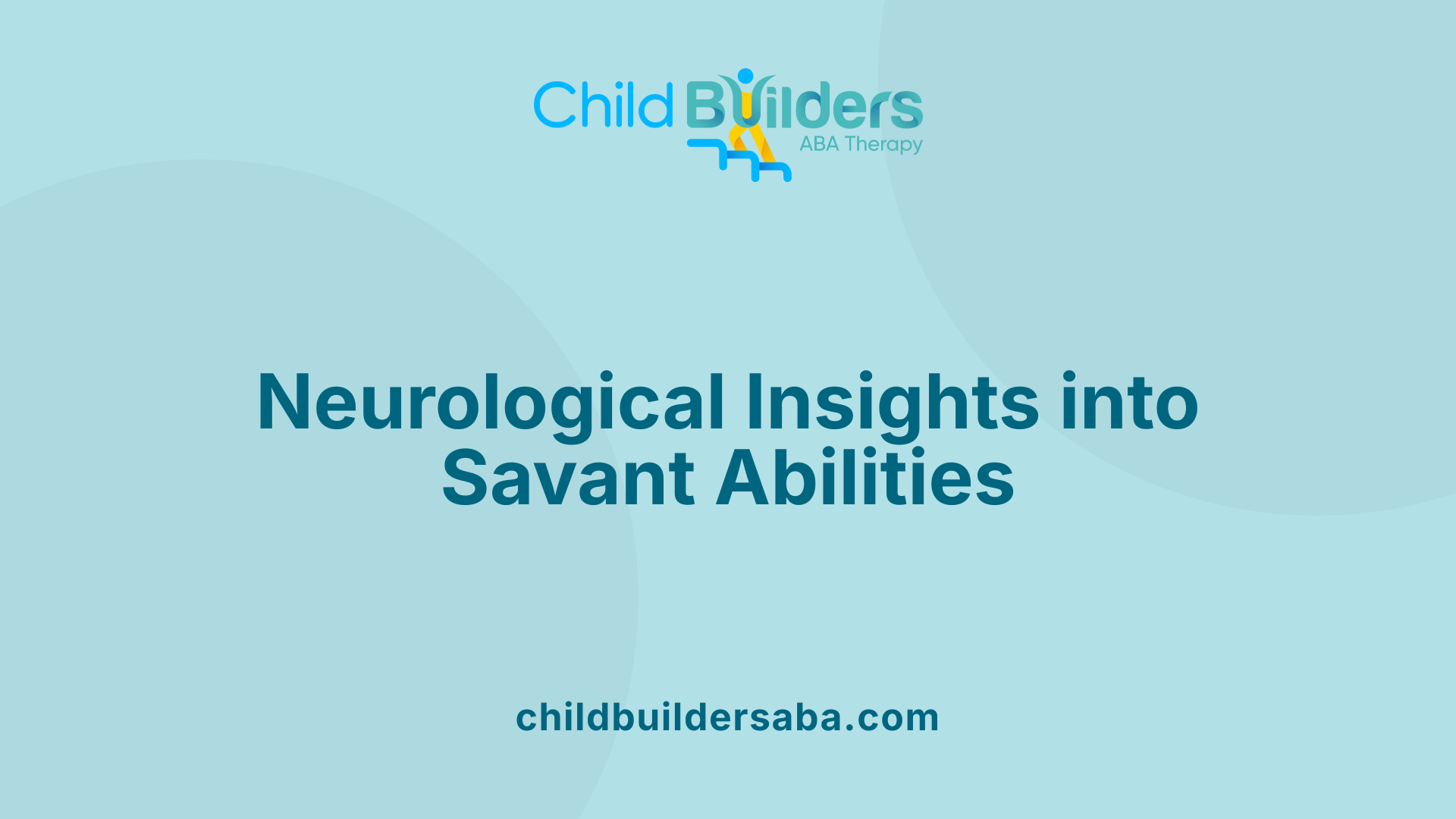Autistic Savant

Understanding the Unique Phenomenon of Savant Syndrome and Its Connection to Autism
Autistic savants represent a remarkable intersection of neurodiversity and extraordinary ability. They showcase how some individuals with developmental disorders, particularly autism spectrum disorder (ASD), can acquire or possess astonishing talents that defy typical expectations. This article explores the nature, causes, examples, misconceptions, and significance of savant syndrome, highlighting its profound implications for understanding the human brain and potential.
What is Savant Syndrome and Its Main Characteristics

What is savant syndrome and what are its general characteristics?
Savant syndrome is a rare and fascinating condition where individuals, often with developmental disabilities such as autism spectrum disorder (ASD), display extraordinary abilities in specific domains like music, art, mathematics, or memory. These remarkable talents stand in stark contrast to their otherwise significant social or intellectual challenges.
People with savant syndrome typically demonstrate exceptional skills that are usually linked to extraordinary memory. They might excel in rapid calculation, detailed artistic creation, calendrical calculation, or musical performance with perfect pitch. These abilities often appear early in life and can sometimes develop after brain injury or neurological disease, which is known as acquired savant syndrome.
While the precise causes of savant syndrome remain unclear, neuroscience suggests that atypical brain organization plays a role. Some theories point to the right hemisphere of the brain taking on functions usually managed by the left, such as language and logic, leading to exceptional skills. The syndrome affects roughly one in a million people and is significantly more common among males, with males being about six times more likely to show savant tendencies.
Importantly, savant syndrome is not classified as a disease but rather as a condition associated with neurodevelopmental differences. Individuals with savant skills often benefit from targeted support and educational interventions that help them leverage their unique talents. Although rare, their abilities can lead to remarkable achievements and personal fulfillment.
General Traits and Skills
Savant skills are usually found in specific categories, including:
- Artistic talents (drawing, painting)
- Musical abilities (playing instruments, perfect pitch)
- Mathematical skills (rapid calculations)
- Calendar calculating (determining the day of the week for any date)
- Exceptional memory (memorizing books, numbers, or detailed information)
Many of these skills are accompanied by obsessive interests and high levels of motivation for their chosen field. Autistic savants, in particular, often exhibit high productivity and distinctive artistic styles, which sometimes reflect characteristics similar to outsider art.
Some savants are classified as talented, showing noteworthy but not extraordinary skills, while prodigious savants possess abilities comparable to genius levels, with fewer than 75 living worldwide.
Prevalence and Demographics
It is estimated that about 10% of individuals with autism spectrum disorder have savant skills, which translate to approximately 1 in every 10 people. The overall prevalence in the general population is extremely low—less than 1 per million. The condition predominantly affects males, with a male-to-female ratio of about 6:1.
Most cases are identified during childhood, although some may develop later due to brain injury or neurological change. Savant abilities tend to develop in a narrow range of categories and often follow a pattern of initial replication, progressing to improvisation and creation, particularly in art and music.
Developmental vs. Acquired Cases
Savant syndrome can be congenital, meaning present at birth, or acquired later in life. Congenital cases are often associated with autism, while acquired cases may follow traumatic brain injury, stroke, or neurological disease. For example, some individuals develop musical or calculation skills after brain damage, which is part of acquired savant syndrome.
In summary, savant syndrome is characterized by profound talents in specific areas, often overshadowing other impairments. The condition highlights the incredible potential of the human brain and continues to be a subject of scientific research to unravel its mysterious origins and mechanisms.
| Aspect | Description | Additional Details |
|---|---|---|
| Prevalence | About 1 in a million | Much higher among autistic individuals (~10%) |
| Typical skills | Art, music, math, calendar calculation, memory | Often obsessive, highly motivated |
| Gender ratio | Males outnumber females by 6:1 | Possible hormonal or genetic factors |
| Onset | Usually childhood; can develop later | Sometimes after brain injury or disease |
| Nature | Congenital or acquired | Not a disease, but a neurodevelopmental condition |
Autism Spectrum Disorder and Savant Syndrome: An Intricate Link

What is the relationship between savant syndrome and autism spectrum disorder?
Savant syndrome is a rare phenomenon where individuals with developmental disabilities, such as autism spectrum disorder (ASD), exhibit extraordinary skills in specific domains like music, art, mathematics, or remarkable memory. This phenomenon is often referred to as a presentation of 'islands of genius' amid broader developmental challenges.
Approximately 10% of people diagnosed with autism showcase savant abilities, a rate significantly higher than the less than 1% prevalence in the general population. This statistic emphasizes the close association between ASD and savant syndrome, suggesting a potential neurodevelopmental link.
Most autistic savants are male, reflecting the overall gender disparity seen in autism diagnoses. The skills often develop early in life, sometimes appearing without formal training, highlighting innate neuropsychological capabilities.
Savant skills in ASD individuals typically include rapid calculation, artistic talents, photographic or eidetic memory, musical prowess, and calendar calculation abilities. These skills often stand out sharply against the backdrop of other autism-related challenges such as impaired communication, social difficulties, and restricted behaviors.
Statistics and prevalence
| Population Group | Prevalence of Savant Skills | Notes |
|---|---|---|
| General population | Less than 1% | Rare in neurotypicals |
| Individuals with autism | About 10% | Significantly higher than in the general population |
| Autistic adults with savant traits | Up to 37% | Based on self-reports and studies |
These statistics underscore how much more common savant skills are among autistic individuals, often linked to specific cognitive and behavioral traits.
Neurodevelopmental interplay
The neurodevelopmental basis for savant syndrome remains a subject of ongoing research. It is believed that certain brain regions may be responsible for these remarkable abilities. Damage or atypical development in the left hemisphere, particularly areas involved in language and logical reasoning, is associated with the emergence of savant skills.
Some theories suggest that in autistic brains, there is an imbalance between hemispheres, with the right hemisphere becoming more dominant or compensating for deficits in the left. This shift may facilitate heightened perceptual abilities, superior pattern recognition, and enhanced memory, all characteristic of savant talents.
Moreover, the state of weak central coherence—a tendency to focus on details rather than the overall picture—is often noted in autism and may contribute to the intensive focus and obsessive interest that support skill development.
Other neuropsychological explanations include hyper-systemizing, which refers to an intrinsic drive to analyze or construct systems, potentially explaining the talent for skills like mathematics, music, or technology.
Theories explaining the link
Several hypotheses exist to explain why savant talents frequently occur alongside autism:
- Biological-Developmental Theory: Proposes that developmental differences in brain wiring lead to specialized skills, particularly in the right hemisphere.
- Modularity of Mind: Suggests that certain cognitive modules can operate independently; in autism, some modules may become hyperactive, leading to specific skills.
- Genetic and Neural Factors: Genetic predispositions influencing both autism and savant abilities are suspected, with familial links noted in some studies.
- Brain Injury Model: Some acquired savants develop abilities following brain damage—especially in the left temporal lobe—supporting the view that injury can lead to functional reorganization and new skills.
In conclusion, while there is no single explanation for the connection between autism and savant syndrome, current evidence suggests a complex interplay of neural, genetic, and developmental factors. These factors work together to produce extraordinary talents sometimes masked by broader developmental impairments, illustrating the remarkable diversity of human cognition.
Traits, Abilities, and Skills of Autistic Savants

What are common traits, abilities, and skills of autistic savants?
Autistic savants are known for their remarkable abilities in specific fields, which often stand in stark contrast to their broader developmental challenges. They typically develop their talents early in life, sometimes without formal instruction, and these skills can also manifest suddenly, especially after brain injury or during certain neurological conditions.
One of the most frequently observed skills among autistic savants is exceptional memory. They often memorize vast amounts of information, such as books, music, or intricate details of their environment. For instance, Kim Peek memorized over 12,000 books, while Daniel Tammet can recite thousands of decimal places of pi. Their memory is often linked to their specialized skills, boosting their ability to perform complex tasks rapidly.
Musical abilities are common, with many savants demonstrating perfect pitch and the capacity to play instruments flawlessly after hearing music just once. Artistic talents also feature prominently, with some creating highly detailed drawings and paintings from memory or their imagination, like Stephen Wiltshire, who can produce accurate cityscapes after a brief observation.
Mathematical skills range from lightning-fast calculations to complex calendar computations, where some can determine the day of the week for any given date instantly. Calendar calculating, a typical savant skill, exemplifies their extraordinary pattern recognition and numerical processing abilities.
Beyond these, savants often excel in spatial or mechanical skills, such as constructing models or understanding intricate systems. The patterns of their abilities typically involve a progression from replication to improvisation and finally to creation, especially in music and art.
Their sensory perception often exceeds that of neurotypical individuals, with heightened sensitivities that can influence their talents. For instance, some autistic savants have perfect pitch or a hyper-awareness of their sensory environment, which enhances their artistic or musical performance.
Autistic savants also exhibit specific cognitive styles characterized by local processing bias—focusing intensely on details and patterns rather than the broader picture. This cognitive style enables their intense focus and mastery in their chosen domain.
Most of these individuals demonstrate obsessive tendencies related to their skills, which serve as both a motivation and a focus for their talents. Their behaviors often include high productivity, persistence in practice, and an intense interest in their specialized area.
Overall, the common traits of autistic savants include:
- Exceptional in specific domains: memory, music, art, mathematics, etc.
- Early or sudden development of skills: often without formal training.
- Enhanced perceptual sensitivities: perfect pitch, visual detail orientation.
- Neurocognitive profile: obsessional behaviors, local processing bias, heightened sensory discrimination.
- Pattern recognition and systemizing: their talents hinge on recognizing and manipulating patterns.
These traits collectively contribute to their extraordinary abilities, making savants remarkable exemplars of how neurodiversity can manifest as exceptional talent.
Neurological Foundations and Theories Behind Savant Abilities

What causes savant syndrome and what is its neurological basis?
The origins of savant syndrome are primarily rooted in the complex workings of the brain. Although research is ongoing, it is clear that atypical brain development and altered neural connectivity are at the heart of this phenomenon.
One prominent theory involves damage or dysfunction in specific brain areas, notably the left anterior temporal lobe. This region, when impaired—such as through injury or developmental anomalies—can result in a release phenomenon, where the right hemisphere of the brain compensates and overdevelops certain skills. This neural reorganization often leads to extraordinary abilities in areas like memory, calculation, and artistic skills.
Neuroimaging studies have played a pivotal role in understanding these mechanisms. These scans show that savants often display differences in brain structure and activity. For example, altered patterns of connectivity—particularly disrupted long-range neural pathways and increased local neural networking—are common in individuals with autism spectrum disorder, a condition frequently associated with savant abilities.
The balance of neural circuits in savants appears to be tilted toward heightened local processing, which supports their exceptional skills. Conversely, this can come at the expense of the integration of information across the brain, which may explain some of the social and cognitive difficulties seen in autistic individuals.
Research also suggests that genetic and developmental factors contribute significantly to savant syndrome. Certain genetic predispositions may influence brain development, leading to the emergence of specific talents. Additionally, the syndrome's occurrence following brain injury implies that neural disinhibition or reorganization in response to trauma can temporarily or permanently unlock hidden abilities.
Multiple hypotheses support these observations. The neural reorganization model emphasizes the role of cortical plasticity and the brain’s capacity to adapt structurally and functionally. Disruption in typical cortical circuits—especially in language and association areas—may cause an individual to develop extraordinary skills in isolated domains, often with minimal or no formal training.
In summary, the neurological basis of savant syndrome involves a mixture of regional brain dysfunction, atypical connectivity patterns, and the brain’s capacity for plastic reorganization. While definitive explanations remain elusive, current models highlight the importance of neural circuitry alterations—particularly the balance between cortical specialization and integration—in fostering these unique talents.
Profiles of Notable Autistic Savants

Can you provide examples of notable autistic savants?
Autistic savants are often recognized for their extraordinary talents in specific areas, despite challenges in social interactions or communication. Among the most well-known figures are Kim Peek, Daniel Tammet, Stephen Wiltshire, and Leslie Lemke. Their stories and achievements provide insight into the remarkable capabilities that can coexist with autism.
Kim Peek, often called a "mega-savant," memorized over 12,000 books and was considered a human library. His exceptional memory and knowledge inspired the character Raymond Babbitt in the film "Rain Man," highlighting the profound capabilities of some autistic individuals. Despite his autism and neurological abnormalities, Peek could rapidly recite detailed information and recall facts with astonishing accuracy.
Daniel Tammet is celebrated for his prodigious memory, linguistic abilities, and unique perception. He can memorize thousands of digits of Pi, surpassing most mathematicians. Tammet also speaks multiple languages fluently, including Icelandic and Finnish, and describes perceiving numbers as colors and shapes—a phenomenon known as synaesthesia.
Stephen Wiltshire is renowned for his detailed cityscape drawings. After just a brief helicopter flight over London, he can produce accurate, intricate sketches of the city from memory. This extraordinary skill has earned him the nickname "human camera," reflecting his exceptional visual memory and artistic talent.
Leslie Lemke, despite cerebral palsy and blindness, is an accomplished pianist. He can perform complex classical pieces after hearing them just once. Lemke’s musical talent highlights how some individuals with motor and sensory impairments develop extraordinary abilities in auditory and musical domains.
Other remarkable autistic savants include Alonzo Clemons, a sculptor known for detailed animal figures, and Tony DeBlois, a blind musician proficient in over 20 instruments. These individuals exemplify the diversity and depth of talents associated with savant syndrome.
Specific skills and talents
Most autistic savants exhibit skills within certain categories:
- Music: perfect pitch, rapid learning of instruments, composition.
- Art: detailed drawings, painting, sculpting.
- Memory: books, facts, dates, numerical calculations.
- Language: multilingual fluency, rapid language learning.
- Mechanical and Spatial Skills: mapmaking, constructing models, intricate puzzles.
These talents often emerge early in life and can sometimes improve with practice.
Impact on society and science
Autistic savants contribute significantly to understanding the brain’s potential and plasticity. Their abilities challenge traditional notions of intelligence and demonstrate that exceptional skills can exist alongside developmental disabilities. Researchers study savants to uncover the neural mechanisms behind these talents, which could inspire new approaches to education and cognitive therapy.
Furthermore, their achievements have influenced artistic and scientific fields. For example, their skills in art and music inspire new techniques and promote appreciation of neurodiversity. They also help foster societal acceptance of individuals with autism, emphasizing their strengths rather than focusing solely on impairments.
Famous examples and their contributions
| Name | Talents | Achievements | Notable Impact |
|---|---|---|---|
| Kim Peek | Memory, reading | Memorized 12,000+ books, knowledge of numerous subjects | Inspired "Rain Man," raised awareness about savant abilities |
| Daniel Tammet | Math, languages, synaesthesia | Memorized digits of Pi, learned multiple languages | Enhanced understanding of perception and cognition |
| Stephen Wiltshire | Visual art | Draws detailed cityscapes from memory | Advanced perceptions of visual-spatial skills |
| Leslie Lemke | Music | Performs complex pieces after hearing once | Demonstrates musical potential in sensory impairments |
| Alonzo Clemons | Sculpture | Creates detailed animal statues | Showcases artistic talents despite disabilities |
Broader context
The stories of these individuals highlight how savant abilities can defy expectations. Most display a passion for learning and sharing their skills, inspiring both the scientific community and the public.
Their cases exemplify the diversity of talents that can be associated with autism and other developmental disorders. These achievements encourage a strengths-based perspective, emphasizing the importance of supporting and nurturing individual gifts.
Understanding these remarkable abilities also opens pathways for developing innovative educational and therapeutic strategies, promoting inclusion and self-actualization for people with autism and related conditions.
By studying renowned savants, researchers hope to unravel the neural basis of extraordinary skills, which may ultimately lead to breakthroughs in brain science and artificial intelligence, enriching our knowledge of human potential.
Myth Busting: Common Misconceptions About Autistic Savants

What are common myths and misconceptions about autistic savants?
Autistic savants are often misunderstood due to various myths and misconceptions. One of the most prevalent myths is that all autistic individuals possess savant skills. In reality, only about 10% of those with autism display such extraordinary abilities, making savant syndrome a rare condition rather than a universal trait among autistic people.
Many people mistakenly believe that savant skills are magical or effortless. However, these abilities typically develop through extensive practice and dedication. For example, a musical savant may have practiced for years or possess an intense obsession that fuels their skills.
Another common misconception is equating savant syndrome with genius or prodigy. While some savants demonstrate prodigious talents, not all are highly intelligent in general. Many may have low or average IQ levels but still showcase extraordinary skills in specific areas, such as calendar calculating or musical performance.
People also tend to think that savant abilities are limited to areas like music or mathematics. In fact, savant skills can span a wide range, including art, memory, spatial skills, mechanical abilities, and language. These talents may develop or change over time, with some individuals acquiring new skills or refining existing ones.
It is also wrongly assumed that savant syndrome occurs only in individuals with autism. Although it is most common among those on the autism spectrum, it can also be associated with other developmental disorders, brain injuries, or neurological conditions. Moreover, the condition is more frequently observed in males, with a ratio of roughly 6:1 compared to females.
Understanding these distinctions is vital for fostering a more accurate appreciation of the diverse capabilities of individuals with neurodevelopmental differences. Recognizing that savant skills, while remarkable, are not magic nor universally present in autism helps to combat stereotypes and fosters more inclusive attitudes.
Below is a summary of common misconceptions versus factual truths about autistic savants:
| Myth | Fact | Details |
|---|---|---|
| All autistic individuals are savants | Only about 10% have savant skills | Most autistic people do not possess extraordinary abilities |
| Savant skills are effortless or magical | They usually require extensive practice | Development of skills involves effort, obsession, or natural talent |
| Savant syndrome is the same as genius | Not all savants are highly intelligent overall | Skills often exist independently of general intelligence |
| Abilities are limited to music or math | Skills include art, memory, spatial, and language | Range of abilities is broad and includes many domains |
| Only autistic people can be savants | It also occurs in those with brain injuries or other disorders | Not exclusive to autism and can develop later in life |
| Savants are mostly females | Males are more frequently affected | Males have a higher prevalence, possibly due to developmental factors |
By dispelling these myths, we recognize that savant talents are complex and varied. They often reflect deep focus, dedication, or neurological uniqueness rather than simple magic tricks or accident.
Understanding these facts promotes an appreciation of individual differences and challenges harmful stereotypes that can hinder social acceptance and support for people with neurodevelopmental conditions. It underscores the importance of personalized approaches that nurture each person's unique talents and potential.
The Broader Significance and Future Perspectives

What is the significance and impact of savant abilities in the context of autism?
Savant abilities in individuals with autism reveal an astonishing capacity for talent that contrasts sharply with their developmental and social challenges. These extraordinary skills—commonly found in areas like music, art, mathematics, or memory—illustrate that individuals with autism can possess remarkable aptitudes that often exceed the expectations set by their general developmental profile.
The connection between savant skills and autism offers profound insights into brain functioning. Many theories suggest that savant abilities may result from atypical neural wiring, such as left hemisphere dysfunction coupled with right hemisphere compensation. This neural reorganization enables enhanced perceptual skills, detail-focused processing, and heightened systemizing — traits that are characteristic of autism.
Moreover, these talents are often associated with specific cognitive and behavioral profiles, including obsessional tendencies, heightened sensory awareness, and focused attention. Recognizing these abilities not only challenges traditional perceptions of autism as solely a deficit but also highlights the potential for developing targeted educational and therapeutic strategies that nurture and leverage these skills.
The existence of savants also raises important questions about the genetic basis of talent. Evidence indicates a genetic overlap between autism and savant syndrome, suggesting that the same biological factors may foster both developmental differences and exceptional abilities. This understanding can deepen research into the biological mechanisms underlying human cognition and talent.
Overall, savant skills emphasize the importance of strength-based approaches in autism, fostering environments that support individual talents. They serve as a reminder that even within disabilities, there are areas of exceptional potential that can enrich not only the lives of individuals but also broaden societal perceptions of human capability.
Educational implications
In educational settings, understanding savant abilities underscores the need for personalized learning approaches. Tailoring teaching methods to certain strengths—such as visual supports, musical training, or spatial reasoning—can enhance engagement and skill development.
Programs that integrate these strengths may improve self-esteem, reduce anxiety, and encourage social interaction. Recognizing and encouraging special talents can also motivate children with autism to participate more actively and thrive academically.
Therapeutic and support strategies
Support strategies should aim to utilize individual savant skills to promote overall development. This might involve specialized art or music therapy, training in memory or calculation, and social skills programs that capitalize on a person's particular interests.
Furthermore, promoting environments that foster obsessional interests can lead to increased motivation and mastery. Support networks, including families, educators, and therapists, play a crucial role in providing encouragement and opportunities for skill expression.
Genetic and neural research
Ongoing research into the genetics and neural substrates of savant syndrome aims to better understand the biological underpinnings of extraordinary talents. discoveries such as specific gene variants or brain regions involved, like the anterior temporal lobe, could lead to innovative interventions.
Experimental modalities, such as low-frequency transcranial magnetic stimulation (TMS), have temporarily induced savant-like skills in neurotypical individuals, opening possibilities for future neuro-enhancement therapies.
Potential for human talent discovery
The study of savant syndrome challenges conventional thresholds of talent and intelligence. It hints at untapped human potential, inspiring exploration into how exceptional abilities can be cultivated.
These insights could influence broader fields—ranging from education reforms to talent identification—potentially uncovering latent abilities in the general population.
| Aspect | Details | Additional Notes |
|---|---|---|
| Typical Skills | Art, music, mathematics, calendar calculation, memory | Usually requires little formal training; develop early |
| Neural Basis | Atypical brain wiring, right hemisphere compensation | Associated with brain injuries, neural reorganization |
| Genetics | Overlap with autism-linked genes | Not yet fully understood, under active investigation |
| Support Strategies | Personalized learning, therapy focusing on strengths | Emphasis on abilities rather than deficits |
| Research Directions | Brain stimulation, genetic analysis | Aim to understand and enhance talent development |
In future perspectives, integrating knowledge from neuroscience, genetics, and psychology could lead to innovative ways to foster talent, not only in individuals with autism but also in the broader population, thereby enriching human potential across all domains.
Harnessing Hidden Potential for a Better Future
Autistic savants serve as a testament to the untapped potential residing within the human brain. Their extraordinary talents challenge conventional notions of disability and open pathways for innovative educational strategies, therapeutic interventions, and scientific exploration. Recognizing and nurturing these unique abilities not only enhances the quality of life for individuals with autism but also enriches our collective understanding of cognition, neurodiversity, and the timeless question of human potential. As research advances and society embraces neurodiversity, the world stands to benefit from unlocking the full spectrum of human talent, inspired by the awe-inspiring capabilities of autistic savants.
References
- Savant syndrome - Wikipedia
- Savant Syndrome | SSM Health Treffert Center
- The savant syndrome: an extraordinary condition. A synopsis
- How Well Do We Understand Autistic Savant Artists - PubMed Central
- Savant Syndrome: What Is It, Causes, Treatment, and More - Osmosis
- Understanding Savant Syndrome - Verywell Mind
- Savant syndrome: What it is, symptoms, and links to autism
- “Autistic savant”: A rare case report - LWW
- 5 amazing people with savant syndrome - Aruma



.jpg)

































































































